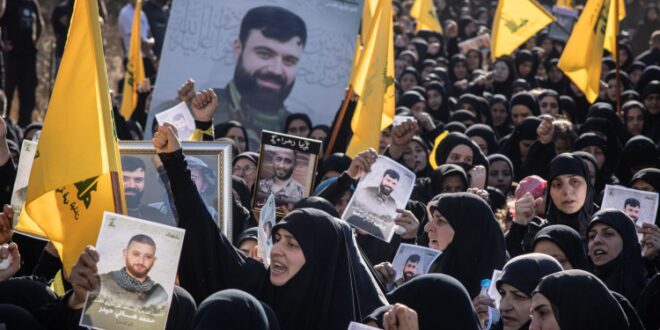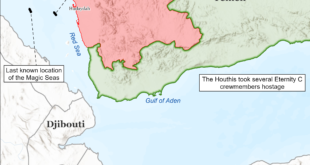Nearly a year on from Hamas’ Oct. 7 offensive against Israel, Israel’s strategic environment — and indeed the strategic landscape of the wider Middle East — has changed profoundly. Hamas’ astounding surprise attack touched off a destructive war with Israel and a limited but fierce regional conflagration between Israel and the Iran-led “Axis of Resistance,” with Lebanese Hezbollah at the forefront. The ongoing war has been multi-fronted, multi-faceted, dynamic, and already highly consequential. While a clear bottom line remains elusive, exploring the war’s primary origins and evolution offers useful indicators. One key takeaway is that recent events have spotlighted the dangers a regional war would pose, thereby underscoring the importance of diplomacy. As such, Israel and the United States must prioritize a settlement of the related Israel-Hezbollah conflict.
Hamas’ and Hezbollah’s thinking in the lead-up to Oct. 7
Ten months ago, Hamas’ offensive was designed to touch off a regional conflagration and inflict an unprecedented blow — potentially even a mortal one — upon Israel. Code-named Al-Aqsa Flood, the attack marked the culmination of an incremental shift in the balance of power between Israel and the Gaza Strip. Hamas, along with several smaller Gaza-based resistance factions, had amassed a massive arsenal of rockets and constructed a vast network of underground tunnels and survivable command-and-control systems; the combination of its capacity to undermine Israel’s resilience and operational continuity, to heavily disrupt daily life, and to threaten Israel’s commercial capital Tel Aviv — all while securing its own military apparatus — had gradually gained Hamas considerable coercive leverage over Israel.
In the years that preceded the war, especially since 2018, Hamas leveraged its growing military power in a successful effort to coerce Israel into abiding by certain thresholds and “rules of the game.” Moreover, Hamas actively compelled Israel to grant it limited but substantial policy and economic concessions — something that bolstered Hamas’ sense of its own strength and helped to create the conditions that made its Oct. 7 offensive feasible. By May 2021, Hamas also managed to extend its deterrence from the Gaza Strip to East Jerusalem and the West Bank, firing missiles and becoming a factor Israel has had to contend with whenever tensions arose in the latter two areas.
Objectively, Israel-Hamas relations remained sharply asymmetrical; but from the vantage point of Hamas, its relative military power had reached a tipping point. Clearly, Hamas saw developments in Israel beginning in early 2023 — Israel’s acute domestic crisis, the rise of an extreme right-wing government, and the impending normalization between Israel and Saudi Arabia — as an opportunity and imperative to act.
A somewhat analogous assessment of Israel’s vulnerability and risk-aversion was gradually shaping Hezbollah’s posture as well. Following the 2006 Lebanon War, Israel-Hezbollah relations had come to be defined and regulated by mutual deterrence. But Hezbollah, too, was becoming increasingly emboldened. In 2022, it waged an unprecedented, and ultimately successful, campaign of coercive diplomacy, in which it effectively threatened Israel with war unless the latter reached an agreement with Lebanon on their contested maritime border. In August 2022, a person described as a “senior jihadi commander” — evidently Hezbollah’s top military commander Fuad Shukr — was cited as saying that Hezbollah had shifted its focus to “qualitative capabilities capable of destroying the Israeli army and not simply preventing it from achieving its objectives.” Shukr had overseen Hezbollah’s acquisition of precision-guided munitions until his recent assassination. Having established deterrence vis-à-vis Israel in the Lebanese sphere, Hezbollah began to push the envelope: among other things, it permitted Hamas to deploy militarily and operate from southern Lebanon. The otherwise distinct fronts were militarily and strategically intertwining, while Israel was growing increasingly deterred.
Hamas’ integration into Iran’s Axis of Resistance
Adding to Hamas’ self-confidence, and ultimately contributing to its decision to go to war, was not only its growing synergy with Hezbollah but the consolidation of the Axis of Resistance and Hamas’ integration into it. Indeed, Hamas, Hezbollah, and Iran took their relations to a new level around 2020. By 2022, a Hezbollah-connected writer noted, Hamas was already “in the heart of the Axis of Resistance.” While not a classic, formal alliance, the axis constitutes a coordinated strategic network of Iran-backed state- and non-state actors that oppose Western influence in the Middle East and aim to reshape the regional order. Thus, while most attention over the past two decades has been devoted to Iran’s nuclear program, regional anxiety regarding Iran’s geopolitical ascendence stemmed from its growing conventional influence in the Middle East.
Recent years have seen tightening relations between Hamas and Iran’s Islamic Revolutionary Guards Corps (IRGC), Yemen’s Houthi rebels, and the “resistance” groups in Iraq. In the past several months, Israel Defense Forces (IDF) units in Gaza have obtained Hamas documents that state that the axis could be harnessed in the service of what Hamas leaders have secretly referred to as “the great enterprise.” Hamas’ assessment stemmed in large part from the experience of its May 2021 conflict with Israel. That conflict, which the IDF codenamed Operation Guardian of the Walls but that Hamas dubbed Sword of Jerusalem, saw the first coordinated, if only sporadic, participation of the Axis of Resistance in the conflict and the establishment of a joint operations room in Lebanon.
Two years later, in April 2023, Israel once again came under coordinated rocket attacks from the Gaza Strip and southern Lebanon, following heightened tensions in a totally different arena, the Temple Mount. The following month, Palestinian Islamic Jihad (PIJ) fired over 100 rockets on Israel after one of its West Bank activists died in a hunger strike while in Israeli detention. The two sides subsequently engaged in an intense four-day conflict; that Hamas avoided joining the fighting helped feed Israel’s misperception of its supposed deterrence of Hamas. The convergence of the previously distinct fronts set the stage for the scenario of a multi-front regional war. True to form, shortly after unleashing its surprise offensive, Hamas leaders urged their various Axis of Resistance partners in the region, as well as Israel’s Arab population, to follow suit. In many ways, the axis, and especially Hezbollah, had been chain-ganged by Hamas into the fray, albeit to a far more limited extent than Hamas had banked on.
Interim scorecard: An existential theme has emerged
Individually and collectively, both Israel on the one hand and Hamas and the Axis of Resistance on the other have scored unprecedented achievements during the ongoing war. The extent to which the still-unfolding post-Oct. 7 conflict will ultimately benefit or undermine the strategic and geopolitical interests of each side remains unclear. Nonetheless, several potential trajectories can be discerned.
First, from a purely strategic perspective, Hamas’ ability to inflict what amounts to “unacceptable costs” (a term borrowed from nuclear deterrence theory) on Israel invited the reciprocal if disproportionate destruction of huge swathes of the Gaza Strip. From a deterrence standpoint, Israel, having suffered the worst catastrophe in its history, exacted devastating material and human costs on Gaza in general and on Hamas and its leadership in particular, in what effectively constitutes a conventional and asymmetrical variation of mutual destruction. Israel’s ferocious retaliation is the most extreme example in its history of “deterrence by punishment.” Israel has devastated a resistance entity in retaliation for a wide-scale guerrilla offensive that featured particularly brutal manifestations of terrorist violence. The establishment of such a devastating standard of violence, namely the deaths of tens of thousands of Palestinian civilians, and the emergence of an “existential” theme in the strategic lexicon of actors such as Israel, Hezbollah, and Iran, will have a formative impact on both Israel and its adversaries going forward.
Second, and related to the previous point, a major surprise to Israel was that, in shocking contrast to its pre-Oct. 7 claims and assessments, it had failed to deter Hamas. Just as important is the fact that, up until Oct. 7, Israel itself had been deterred and constrained by both Hamas and Hezbollah. This realization alone will likely inspire an uncompromising preemptive mindset in Israel toward these actors in future clashes.
Third, the removal of Hamas from the strategic chessboard, even if temporarily, will not only sever the strategic linkage between Gaza and southern Lebanon but result in a reconfiguration within the Axis of Resistance itself. The Iran-led camp will need to compensate for the elimination of the Gaza Strip as a strategic factor. This could lead to increased collaboration among the remaining Axis of Resistance forces in the region. In this respect, Yemen’s Houthi movement (officially Ansar Allah) has emerged as a resolute, resilient, and effective regional actor. Owing to their geostrategic position, not only have the Houthis challenged Israel with a steady trickle of missiles and long-range drones, but they have also demonstrated a capacity to massively disrupt international shipping in the global chokepoint of Bab el-Mandeb and, by extension, in Egypt’s equally vital Suez Canal. Barely a regional actor until recent years, the Houthis have since integrated into the Axis of Resistance and become a global concern. In addition, besides its efforts to destabilize the West Bank, the axis is expected to increase its efforts to threaten the Israeli-Jordanian border. In June, an official in Iraq’s Hezbollah Brigades noted, “Jordan, given its geographic position, is extremely important to the Axis of Resistance.” Granted, these developments have been met with increased cooperation between Israel, Saudi Arabia, and their regional partners.
Fourth, Hezbollah, whose core logic and strategy revolve around deterrence, would need to compensate for the loss of its strategic ally in Gaza. Indeed, Israel could become better positioned to directly take on Hezbollah, the tip of the spear of Iran’s forward deterrence strategy and in many ways the most important component in the entire Axis of Resistance. The current conflict leaves little doubt that a full-scale Israel-Hezbollah war would not simply be a “third Lebanon war” but a confrontation of an altogether different magnitude. Beyond the destruction that both parties would incur, such a war would, in all likelihood, expand beyond the Israel-Lebanon sphere.
While this could pave the way for mutual deterrence and an extended period of strategic stability, major challenges lie ahead. Hezbollah is expected to accelerate its military build-up and seek more precision-guided capabilities and air-defense systems. Israel will likely exhibit increased resolve in its attempts to enforce red lines and prevent Hezbollah from offsetting its aerial superiority. The barrier of fear, which had deterred Israel from operating in Lebanon in the decade and a half that preceded the current war, and from violating Lebanese airspace since 2019, has been shattered.
Short of a settlement or agreement that regulates the Israeli-Lebanese border, these factors are virtually guaranteed to keep the Israel-Hezbollah conflict active, at least to a certain degree. In this regard, from a geopolitical perspective, arguably the most crucial factor remains the Israeli-Lebanese sphere. Regional stability hinges, in many ways, on the ability of the two countries to resolve all points of contention, promote some sort of a diplomatic settlement, and facilitate the return of the evacuated civilian population to a reconstructed northern Israel and southern Lebanon.
Fifth, as regards the emergence of a multi-front, coordinated “resistance” network in the region, recent months have made it abundantly clear that the Axis of Resistance is a regional force to be reckoned with. Whereas Israel overcame the barrier of fear versus Hezbollah, Iran, too, has also overcome a barrier of its own by directly targeting Israel from its territory. In April, Iran, in conjunction with the Houthis in Yemen and with support from Iraq’s resistance groups, unleashed hundreds of ballistic missiles and drones on Israel in retaliation for Israel’s killing of high-ranking Iranian figures in what Iran described as its consular building in Damascus. This created a standard of regional violence that will cast a grave shadow on the rival parties’ calculations and threat perceptions.
Looking forward: The imperative of diplomacy
Although, as noted above, the current conflict defies clear-cut bottom lines, at the most overarching level, recent months have arguably imposed a clearer appreciation of the potential magnitude of destruction that an uncontrolled regional war would entail. Moreover, it illustrated the degree to which the Israel-Hezbollah conflict has become a regional center of gravity.
Not only has Hezbollah grown into a potent military force, but it is today strategically tethered to other regional forces and arenas like never before. This precarious state of affairs has a direct bearing on the US and Iran. Both states must plan and act on the assumption that an Israel-Hezbollah war could also draw them into a direct clash. While the analogy is admittedly imperfect, this resembles the reality of the Cold War, during which the two superpowers remained cautiously cognizant of a scenario in which a local conflict between their opposing clients could spiral into a US-Soviet showdown. A decade ago, faced with unappealing binary options, the US and Iran thus successfully forged a diplomatic middle ground.
While the Axis of Resistance has reached a new level of consolidation, its various members hardly share identical domestic constraints. For instance, Hezbollah faces strong criticism from Lebanese parties who do not share its vision or preparedness to take risks for the Palestinians. War-battered Syria, too, has made do with serving mostly as a logistical arena. Such discrepancies and constraints are important for confronting the axis.
No easy or even practical solution appears to the Israeli-Palestinian conflict. But the war has rendered the following proposition brutally clear: ignoring or otherwise bypassing the Palestinian issue is a reckless wager. Israel’s prewar approach, according to which the Palestinians must not be permitted to wield veto power over Israeli-Saudi normalization — as stressed by Israeli Prime Minister Benjamin Netanyahu at the United Nations a mere two weeks before the war — precipitated Hamas’ momentous gamble.
All of the above highlights the crucial importance of regional diplomacy. We are left with the menacing question of whether a regional equilibrium is currently possible or whether the region and its people must suffer further destruction and turmoil before it stabilizes.
 Eurasia Press & News
Eurasia Press & News


